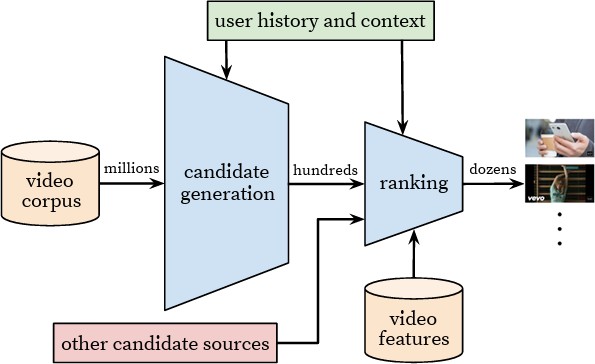Introduction
In the digital age, YouTube has revolutionized how people consume content. With over 2 billion active monthly users, YouTube’s recommendation system is critical in shaping the content experience for every individual viewer. Its ability to predict and suggest videos tailored to users’ interests is not only key to user engagement but also a massive driver for YouTube’s business model, especially in terms of monetization.
At the heart of YouTube’s recommendation system is a complex integration of Artificial Intelligence (AI), Deep Learning, Collaborative Filtering, and Data Mining techniques. These technologies work in tandem to ensure that users are constantly presented with content that is relevant, engaging, and personalized. By optimizing for both engagement and monetization, YouTube has become an indispensable platform in today’s content consumption landscape. In this blog, we will delve deep into how YouTube’s recommendation system works, its reliance on deep learning and collaborative filtering, how AI predicts trends, and how these technologies are optimized for better monetization. We will explore case studies and practical examples to illustrate these concepts and add further detail to our understanding.

1. Understanding YouTube’s Recommendation System
The YouTube recommendation system operates as a highly complex, multi- stage pipeline. Every step in the pipeline involves processing user data, evaluating video content, and ensuring the most relevant content is shown at the right time.
The Goal of YouTube’s Recommendation Engine
The fundamental goal of YouTube’s recommendation system is to maximize user engagement and watch time, two key performance indicators for the platform. More engagement leads to longer viewing sessions, and longer viewing sessions lead to more ad revenue. The recommendations aim to keep users engaged by suggesting content that aligns with their interests, watch history, and other engagement metrics.
Data Inputs Used by the System
YouTube’s recommendation engine uses a variety of data inputs to generate personalized recommendations:
- User Data: This includes user interaction history (e.g., previous video views, likes, shares, and comments) and demographic information such as location, age, and gender.
- Content Data: The system uses metadata such as video titles, descriptions, tags, and even visual content analysis to classify the videos.
- Engagement Data: Metrics such as watch time, likes, dislikes, comments, and shares help rank the relevance of videos.
- Behavioral Data: YouTube also analyzes how users engage with videos over time, adjusting recommendations based on shifting preferences.
2. Deep Learning in YouTube’s Recommendation System
Introduction to Deep Learning
Deep learning is a subset of machine learning that uses multi-layered artificial neural networks to process data. It’s particularly well-suited for handling large datasets and making sense of unstructured data such as videos and images. In the case of YouTube, deep learning helps analyze both user behavior and video content to predict which videos are likely to be watched next.
Neural Networks and Their Role
Neural networks, especially deep neural networks (DNNs), are at the core of YouTube’s recommendation system. They process data through multiple layers of nodes (or neurons) to identify patterns and make predictions. These
predictions influence what videos get recommended.
Some of the key types of neural networks used in YouTube’s recommendation system include:
- Convolutional Neural Networks (CNNs): CNNs are primarily used for processing visual data, such as analyzing video thumbnails, video frames, and even the visual content within the videos themselves. This helps YouTube recommend visually similar videos based on thumbnail patterns and aesthetic similarities.
- Recurrent Neural Networks (RNNs): RNNs are designed to handle
- sequences of data, which makes them ideal for processing user behavior over time. For example, RNNs can identify patterns in a user’s video- watching history and predict what content they are likely to watch next.
- Long Short-Term Memory Networks (LSTMs): A specific type of RNN, LSTMs are particularly useful for capturing long-term dependencies in user behavior. LSTMs help improve YouTube’s recommendation accuracy by learning from a user’s long-term preferences and adjusting recommendations accordingly.
Personalization and Deep Learning
Personalization is at the heart of YouTube’s recommendation system. Deep learning allows YouTube to tailor video recommendations based on both explicit feedback (such as likes, comments, or subscriptions) and implicit feedback (like watch time, replays, or shares). The system learns to predict what content a user might enjoy based on complex patterns that are not immediately obvious from direct interactions alone. For instance, if a user watches a lot of fitness-related content but hasn’t liked or commented on any, YouTube’s deep learning models can still recommend similar fitness videos based on other users’ behavior or content similarity.
3. Collaborative Filtering: The Power of User Behavior
Collaborative filtering is another cornerstone of YouTube’s recommendation system. It relies on the assumption that users who have interacted with similar content will have similar preferences in the future.
Types of Collaborative Filtering
There are two main types of collaborative filtering methods used in YouTube’s recommendation engine:
- User-Based Collaborative Filtering: This method recommends videos by identifying other users who have similar preferences and suggesting videos they have watched. For example, if User A and User B both watch similar videos, YouTube may suggest videos watched by User B to User A.
- Item-Based Collaborative Filtering: This method focuses on the relationship between items (videos) rather than users. If a user watches Video X, the algorithm suggests other videos that are commonly watched with Video X. This method helps build connections between content, even if the user hasn’t previously interacted with it.
Application of Collaborative Filtering on YouTube
Collaborative filtering helps surface content that a user may not have discovered on their own. For instance, the system often suggests videos based on a user’s viewing history and behavior, even if the user has never searched for that type of content.
4. AI and Trend Prediction
In addition to personalized recommendations, AI plays a significant role in predicting viral content. By analyzing engagement patterns across the platform, YouTube’s AI models can identify videos that are likely to go viral and start recommending them to a broader audience.
How AI Predicts Trends
AI analyzes real-time data, such as the rate at which a video is gaining views, likes, shares, and comments, to forecast its potential to go viral. When a video begins gaining traction, the system promotes it to users with similar interests, which accelerates the growth of the video’s viewership.
For example, if a video is gaining popularity in a specific region or among a particular demographic, YouTube can adjust its recommendation algorithms to suggest this video to other users who share similar interests.
Content Discovery and AI
AI-driven trend prediction also helps YouTube surface fresh content to users. As new videos are uploaded, AI can recommend emerging trends and content categories, ensuring that users are always presented with the most relevant and current videos, even if they haven’t interacted with that type of content before.
5. AI and Monetization: Optimizing Ad Placements
Monetization is a core aspect of YouTube’s business model, and AI plays a central role in optimizing ad placements to ensure effective targeting and revenue maximization.
Targeted Ads Using AI
YouTube’s AI uses user data such as watch history, demographics, interests, and even browsing behavior to identify the most relevant ads for each user. For example, a user who regularly watches makeup tutorials might see ads for beauty products. YouTube’s deep learning models can predict which ads are likely to resonate with individual viewers, improving click-through rates (CTR) and ad performance.
Ad Placement Optimization
YouTube uses AI to optimize the timing and placement of ads in videos. Through reinforcement learning, the system learns the best times to display ads to maximize engagement and minimize disruption to the user experience. AI helps determine the most effective ad intervals, adjusting in real time based on user interactions and video length.
This AI-driven ad optimization ensures that ads are shown when they are least likely to disrupt the viewer’s experience, while still maximizing revenue for creators and YouTube.
6. Ethical Considerations in YouTube’s Recommendation System
As powerful as YouTube’s recommendation system is, it also raises several ethical concerns. Below are some key ethical issues surrounding its use:
Filter Bubbles and Echo Chambers
A common criticism of YouTube’s recommendation system is the creation of filter bubbles. This happens when users are only exposed to content that aligns with their existing beliefs, preferences, or biases. It can limit users’ exposure to diverse viewpoints and reinforce existing opinions, potentially contributing to polarization, especially in political or social contexts.
Promoting Harmful Content
There have been instances where YouTube’s recommendation algorithm promoted harmful content, including conspiracy theories, misinformation, or sensationalized videos. In response, YouTube has been updating its algorithm to improve content moderation and prioritize authoritative sources, particularly in the case of health or political topics.
Privacy Concerns
YouTube’s recommendation system relies heavily on user data, raising concerns about privacy. Given the vast amount of personal data YouTube collects (including watch history, search queries, and even user behavior on other Google services), there is ongoing debate about how this data should be used and protected.
Case Studies: Real-World Examples of YouTube’s Recommendations at Work
The Rise of Vlogging Channels
YouTube’s recommendation system has played a pivotal role in the success of vlogging channels. Popular vloggers, such as Casey Neistat and Zoella, have attributed much of their success to YouTube’s ability to recommend their videos to audiences who are likely to enjoy them based on past behavior. By continuously presenting viewers with videos similar to their previous viewing patterns, the recommendation system allows vloggers to expand their audience.
The Case of Music Videos
Music videos are another example of how YouTube’s recommendation system drives engagement. Popular artists’ videos often gain traction because the system suggests them to users who have shown an interest in similar genres. Through AI-driven recommendations, the platform can predict which music videos are likely to go viral based on patterns in user engagement.
The Future of YouTube’s Recommendation System
As AI continues to evolve, YouTube’s recommendation system is set to become even more sophisticated:
- More Personalization: Advances in deep learning will enable YouTube to provide even more personalized content, adapting to subtle shifts in a user’s interests.
- Ethical AI: YouTube is investing in improving the transparency and ethics of its algorithms, especially around issues like filter bubbles and harmful content.
- Augmented and Virtual Reality (AR/VR): With the rise of AR and VR technologies, YouTube’s recommendation system may eventually suggest immersive, interactive content, rather than traditional videos.
Conclusion:
YouTube’s recommendation system is a powerful blend of AI, deep learning, collaborative filtering, and data science techniques. It enables YouTube to engage billions of users worldwide by providing personalized video recommendations that maximize user satisfaction and drive revenue through ad placements. As YouTube continues to evolve and improve its system, it will undoubtedly remain at the forefront of digital content delivery, offering ever more engaging and immersive experiences to users across the globe.











